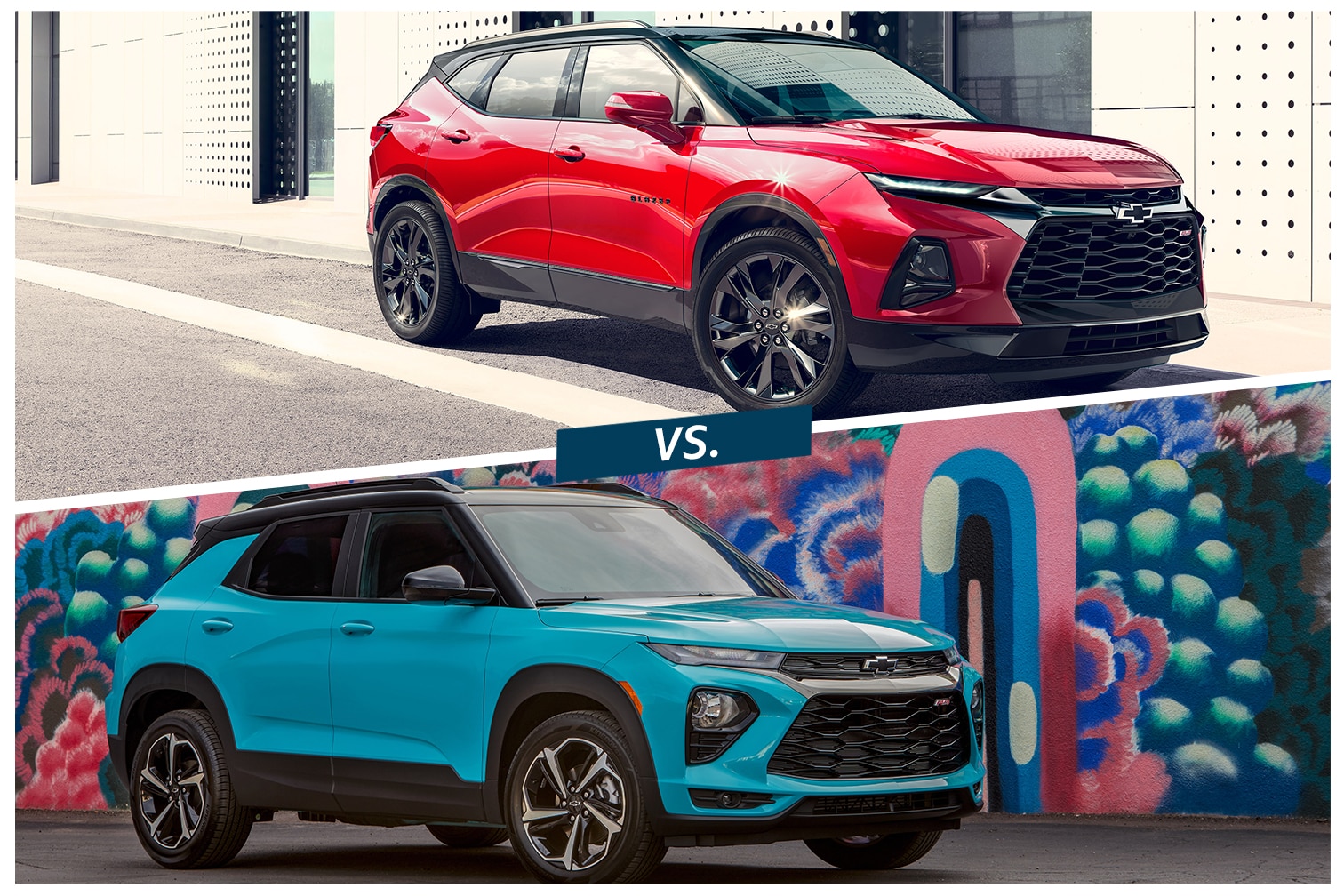Compared: 2022 Chevrolet Blazer vs. 2022 Chevrolet Trailblazer
Occupying different classes, these two crossovers have little in common apart from their names.
 Chevrolet
Chevrolet
QuickTakes:
It's easy to understand why someone would be confused about the Chevrolet Blazer and Trailblazer. The names are so similar, and yet these two crossovers are considerably different in size and price. They're also notably different from the vehicles that wore these badges in other decades. The Blazer was a full-size SUV in a past life, but the 2022 model is a five-passenger, midsize crossover. And the Trailblazer nameplate once adorned a midsize model, but now it’s on a subcompact crossover. If you’re looking for an easy way to remember the difference, just tell yourself that b means big and t means tiny.
 Chevrolet Blazer
Chevrolet Blazer
Chevrolet Blazer vs. Chevrolet Trailblazer: Price
The Blazer opens around $35,000 with front-wheel drive and a 228-hp, turbocharged four-cylinder. On all but the base model, Chevy offers (or supplies as standard) a 308-hp V6. You can spec all-wheel drive regardless of trim: It’s $2,700 on the lower two and $2,900 on the top two.
 Chevrolet Trailblazer
Chevrolet Trailblazer
The Trailblazer starts close to 12 grand below the Blazer. The lowliest model, with a base price of about $23,000, makes do with 137 horses from a turbocharged, 1.2-liter three-cylinder. Buyers who step up a trim have the option to upgrade to a 1.3-liter three with 18 more ponies, and if you want all-wheel drive—which costs between $1,500 and $2,000, and swaps the standard continuously variable transmission for a nine-speed automatic—that larger-displacement engine is what you get.
 Chevrolet Blazer
Chevrolet Blazer
Chevrolet Blazer vs. Chevrolet Trailblazer: Interior
While both crossovers seat five, the Blazer has 108 cubic feet of passenger space to the Trailblazer’s 98, and it boasts six more cubes of cargo room, with a total of 31. It’s also better appointed than the subcompact, though that’s not hard to do. The Trailblazer, in base form, has few features. If you want such amenities as automatic climate control and a proximity key with push-button start, you’ll need to pick a higher trim level than the LS. Heck, cruise control costs extra on the base Trailblazer.
 Chevrolet Trailblazer
Chevrolet Trailblazer
The Blazer, meanwhile, comes standard with all of those things, and it offers optional leather upholstery and ventilated front seats—two features you won’t find on any Trailblazer. Chevy also equips better-than-base Blazers with a power liftgate and blind-spot monitoring, but if you want those niceties on a Trailblazer, you’ll have to pay for them.
 Chevrolet Blazer
Chevrolet Blazer
Chevrolet Blazer vs. Chevrolet Trailblazer: Fuel Economy
Unsurprisingly, the subcompact achieves better fuel economy than the midsizer. The base Trailblazer, with front-wheel drive and the 1.2-liter engine, sees 29 mpg in the city and 31 on the highway, but buyers can score two more points on the freeway cycle by opting for the 1.3-liter. They’ll lose those gains, though, if they add all-wheel drive, which knocks fuel economy down to 26 mpg city and 30 mpg highway.
 Chevrolet Trailblazer
Chevrolet Trailblazer
The Blazer returns, at best, 22 and 29 mpg on the EPA’s respective city and highway cycles. That’s assuming you stick with the base four-cylinder and front-wheel drive. Upgrade to the V6 and/or all-wheel wheel, and you’ll take a slight hit in the ratings, with the worst-performing Blazer seeing 19 mpg in the city and 26 on the highway.
Written by humans.
Edited by humans.
 Beth Nichols
Beth NicholsAfter graduating from the University of Michigan, Beth Nichols stumbled into automotive journalism and found her footing, jumping between a few car magazines before going freelance. Her head, once full of useless facts about literature and art history, now holds useless facts about vehicles. She edits, checks, and occasionally creates content for Capital One, and though she understands it’s customary to write a bio in the third person, I don’t like it.
Related articles
View more related articles